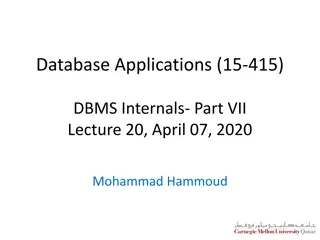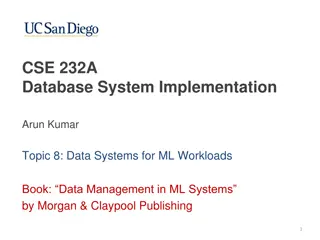Wander Join: Online Aggregation via Random Walks in Database Workloads
Wander Join is a technique for online aggregation using random walks, addressing challenges in efficiency and correctness in both transactional and analytical database workloads. It allows for complex analytical queries such as TPC-H queries and provides insights into revenue loss due to returned orders. Other related methods like Ripple Join are also discussed.
Download Presentation

Please find below an Image/Link to download the presentation.
The content on the website is provided AS IS for your information and personal use only. It may not be sold, licensed, or shared on other websites without obtaining consent from the author. Download presentation by click this link. If you encounter any issues during the download, it is possible that the publisher has removed the file from their server.
E N D
Presentation Transcript
Wander Join: Online Aggregation via Random Walks Feifei Li Bin Wu, Ke Yi Zhuoyue Zhao University of Utah Hong Kong University Shanghai Jiao Tong of Science and Technology University
Database Workloads Transactional (OLTP) Deduct ? dollars from account A, credit ? dollars to account B Challenge: Efficiency and correctness (ACID) Analytical (OLAP) Large fraction of data Many tables Complex conditions Challenge: Efficiency Correctness? 2 Wander Join: Online Aggregation via Random Walks
Complex Analytical Queries (TPC-H) SELECT SUM(l_extendedprice * (1 - l_discount)) FROM customer, lineitem, orders, nation, region WHERE c_custkey = o_custkey AND l_orderkey = o_orderkey AND l_returnflag = 'R' AND c_nationkey = n_nationkey AND n_regionkey = r_regionkey AND r_name = 'ASIA' This query finds the total revenue loss due to returned orders in a given region. 3 Wander Join: Online Aggregation via Random Walks
Online Aggregation [Haas, Hellerstein, Wang, SIGMOD97] SELECT ONLINE SUM(l_extendedprice * (1 - l_discount)) FROM customer, lineitem, orders, nation, region WHERE c_custkey = o_custkey AND l_orderkey = o_orderkey AND l_returnflag = 'R' AND c_nationkey = n_nationkey AND n_regionkey = r_regionkey AND r_name = 'ASIA' WITHTIME 60000 CONFIDENCE 95 REPORTINTERVAL 1000 ? + ? ? ? ? Confidence interval: Pr ? ? < ? < ? + ? > 0.95 4 Wander Join: Online Aggregation via Random Walks
Ripple Join [Haas, Hellerstein, SIGMOD99] Store tuples in each table in random order In each step Reads the next tuple from a table in a round-robin fashion Join with sampled tuples from other tables Works well for full Cartesian product But most joins are sparse 5 Wander Join: Online Aggregation via Random Walks
A Running Example Nation CID BuyerID OrderID OrderID ItemID Price US 1 4 1 4 301 $2100 What s the total revenue of all orders from customers in China? US 2 3 2 2 304 $100 China 3 1 3 3 201 $300 UK 4 5 4 4 306 $500 China 5 5 5 3 401 $230 ?: size of each table, e.g., 109 ?: # tuples taken from each table ?: # estimators, e.g., 103 US 6 5 6 1 101 $800 China 7 3 7 2 201 $300 1 UK 8 5 8 ?2= ? 5 101 $200 ?3 Japan 9 3 9 4 301 $100 ? = ?2/3?1/3= 107 UK 10 7 10 2 201 $600 6 Wander Join: Online Aggregation via Random Walks
Join as a Graph ?1?2 ?3 Conceptual only Never materialized 7 Wander Join: Online Aggregation via Random Walks
Join as a Graph ?1?2 ?3 Conceptual only Never materialized 8 Wander Join: Online Aggregation via Random Walks
Join as a Graph Nation CID BuyerID OrderID OrderID ItemID Price US 1 4 1 4 301 $2100 US 2 3 2 2 304 $100 SELECT SUM(Price) FROM Customers C, Orders O, Items I WHERE C.Nation = China C.CID = O.BuyerID O.OrderID = I.OrderID China 3 1 3 3 201 $300 UK 4 5 4 4 306 $500 China 5 5 5 3 401 $230 US 6 5 6 1 101 $800 China 7 3 7 2 201 $300 UK 8 5 8 5 101 $200 Japan 9 3 9 4 301 $100 UK 10 7 10 2 201 $600 9 Wander Join: Online Aggregation via Random Walks
Sampling by Random Walks Nation CID BuyerID OrderID OrderID ItemID Price US 1 4 1 4 301 $2100 US 2 3 2 2 304 $100 SELECT SUM(Price) FROM Customers C, Orders O, Items I WHERE C.Nation = China C.CID = O.BuyerID O.OrderID = I.OrderID China 3 1 3 3 201 $300 UK 4 5 4 4 306 $500 China 5 5 5 3 401 $230 US 6 5 6 1 101 $800 China 7 3 7 2 201 $300 UK 8 5 8 5 101 $200 Japan 9 3 9 4 301 $100 UK 10 7 10 2 201 $600 10 Wander Join: Online Aggregation via Random Walks
Sampling by Random Walks Nation CID BuyerID OrderID OrderID ItemID Price US 1 4 1 4 301 $2100 US 2 3 2 2 304 $100 SELECT SUM(Price) FROM Customers C, Orders O, Items I WHERE C.Nation = China C.CID = O.BuyerID O.OrderID = I.OrderID China 3 1 3 3 201 $300 UK 4 5 4 4 306 $500 China 5 5 5 3 401 $230 US 6 5 6 1 101 $800 China 7 3 7 2 201 $300 UK 8 5 8 5 101 $200 Japan 9 3 9 4 301 $100 UK 10 7 10 2 201 $600 11 Wander Join: Online Aggregation via Random Walks
Sampling by Random Walks Nation CID BuyerID OrderID OrderID ItemID Price US 1 4 1 4 301 $2100 US 2 3 2 2 304 $100 SELECT SUM(Price) FROM Customers C, Orders O, Items I WHERE C.Nation = China C.CID = O.BuyerID O.OrderID = I.OrderID China 3 1 3 3 201 $300 UK 4 5 4 4 306 $500 China 5 5 5 3 401 $230 US 6 5 6 1 101 $800 China 7 3 7 2 201 $300 UK 8 5 8 5 101 $200 Japan 9 3 9 4 301 $100 UK 10 7 10 2 201 $600 12 Wander Join: Online Aggregation via Random Walks
Sampling by Random Walks Nation CID BuyerID OrderID OrderID ItemID Price US 1 4 1 4 301 $2100 US 2 3 2 2 304 $100 SELECT SUM(Price) FROM Customers C, Orders O, Items I WHERE C.Nation = China C.CID = O.BuyerID O.OrderID = I.OrderID ?: size of each table size, e.g., 109 ?: # tuples taken from each table = # random walks ?: # estimators, e.g., 103 ? = ? = 103 China 3 1 3 3 201 $300 UK 4 5 4 4 306 $500 China 5 5 5 3 401 $230 US 6 5 6 1 101 $800 China 7 3 7 2 201 $300 UK 8 5 8 5 101 $200 $??? $??? ???????? ????.= Unbiased estimator: Japan 9 3 9 4 301 $100 ?/? ?/? ?/? UK 10 7 10 2 201 $600 13 Wander Join: Online Aggregation via Random Walks
Walk Plan Optimization ?1?2 ?3 Structure of the data graph Selection predicates Starting table: use index Table in the middle: reject random walk Data distribution ?1?2 ?1?2 Non-uniformity may not be a bad thing! 5 6 3 0 1 1 1 1 1 1 1 1 5 6 3 0 ??? ?1 ?2 > ??? ?2 ?1 ??? ?1 ?2 < ??? ?2 ?1 14 Wander Join: Online Aggregation via Random Walks
Walk Plan Optimizer Enumerate all plans Conduct ~ 100 trial random walks using each plan Measure the variance of each plan Select the best plan All trials runs are still useful 15 Wander Join: Online Aggregation via Random Walks
Convergence Comparison 16 Wander Join: Online Aggregation via Random Walks
Wander Join in PostgreSQL Logarithmic growth due to B-tree lookup to find random neighbours 17 Wander Join: Online Aggregation via Random Walks
Running on Insufficient Memory (4GB) Insufficient memory incurs a heavy, one-time penalty Growth is still logarithmic Fundamentally: Random sampling at odds with hard disks But does it matter? Spark, In-Memory DB, RAM cloud The algorithm is embarrassingly parallel Turbo DBO [Dobra, Jermaine, Rusu, Xu, VLDB 09] 18 Wander Join: Online Aggregation via Random Walks
Accuracy Achieved in 1/10 Time of Full Join 19 Wander Join: Online Aggregation via Random Walks
Wander Join vs Ripple Join Wander Join Ripple Join Sampling methodology Independent but non-uniform Uniform but non-independent Index needed? Yes Index or random storage Confidence interval computation Convergence time (20GB data, 3 tables) Complicated, ?(??) time ?: # tables Easy, ?(?) time ~ 3s ~ 50s Scalability Logarithmic Slightly less than linear PostgreSQL (finished) Oracle (in progress) SparkSQL (in progress) System implementation Informix (internal project) DBO 20 Wander Join: Online Aggregation via Random Walks
Online Aggregation vs Data Cube Online Aggregation Data Cube Queries Online, ad hoc Offline, fixed Latency Seconds Hours, then milliseconds Query mode One at a time Batch Accuracy Small error No error Data schema Any (relational, graph) Multidimensional cube Work with OLTP Integrated Separate Online, ad hoc, interactive data analytics Target scenario Monthly report 21 Wander Join: Online Aggregation via Random Walks
Index Ripple Join [Lipton, Naughton, Schneider, SIGMOD90] Nation CID BuyerID OrderID OrderID ItemID Price US 1 4 8 4 301 $2100 US 2 3 5 2 304 $100 China 3 1 3 3 201 $300 UK 4 5 4 4 306 $500 China 5 5 2 3 401 $230 US 6 5 3 1 101 $800 China 7 3 7 2 201 $300 UK 8 5 1 5 101 $200 Japan 9 3 9 4 301 $100 UK 10 7 10 2 201 $600 23 Wander Join: Online Aggregation via Random Walks
Sampling from a B-tree [Olken, 93] 4 3 2 Sampling from an aggregate (ranked) B-tree is easy But incurs heavy cost for transactions need to modify existing B-tree implementations 24 Wander Join: Online Aggregation via Random Walks
Rejection Sampling [Olken, 93] Imagine each node has maximum fanout Reject as soon as it walks out of bound 25 Wander Join: Online Aggregation via Random Walks
Non-Uniform Sampling 1 1 1 1 1 1 1 1 1 3 4 3 4 3 4 3 2 3 3 3 4 3 3 3 3 3 2 As long as we can compute the sampling probability, wander join still works! 26 Wander Join: Online Aggregation via Random Walks
Compare with BlinkDB [Agarwal, Mozafari, Panda, Milner, Madden, Stoica, 13] Wander Join BlinkDB Methodology Query Sampling Sampling Query Sampling method Random walks Stratified sampling Big table joining a small table (no sampling on small table) Joins supported Any Error Reduce over time Fixed Data schema Any (relational, graph) Star / snowflake Work with OLTP Integrated Separate Group-by support Unbalanced Balanced 27 Wander Join: Online Aggregation via Random Walks

 undefined
undefined























